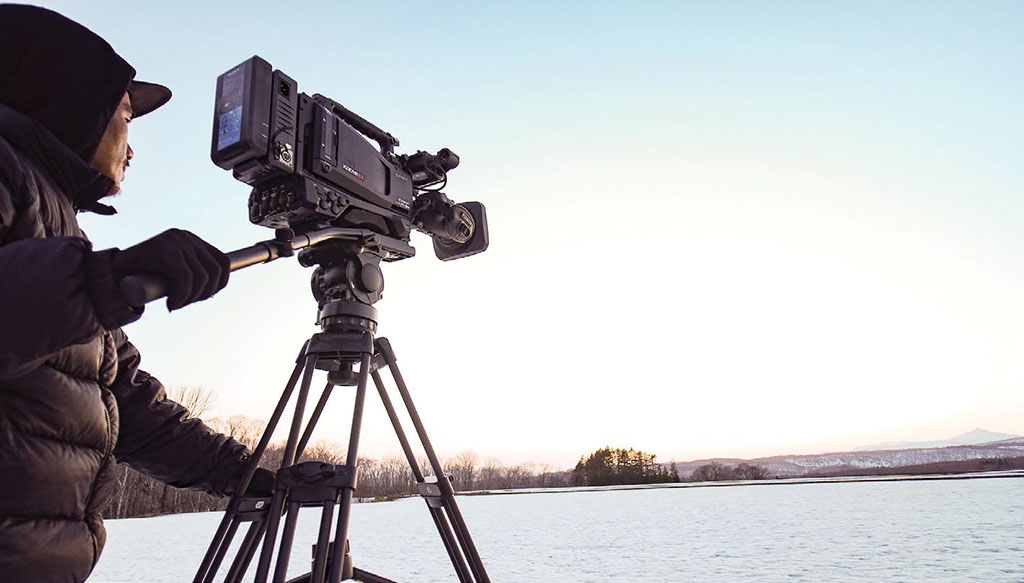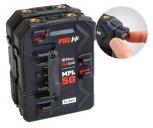News Gear Vendors Stress Speed to Air
SEATTLE—News crews are always in a hurry, trying to be the first with a liveshot from the latest breaking story. Two critical pieces of gear that facilitate speed of deployment are tripods and battery packs and manufacturers are making pods and power supplies that offer new, innovative tools for news shooters.
“We really had news crews in mind when we designed our Flowtech tripods,” said Tobias Keuthen, global brand market director for Vitec Production Solutions Division. “Those are the ones who are really run-and-gun shooters. Our number one goal was ‘how can we minimize the time you need to set up your camera with tripod and the fluid head?’”
BEST PLACEMENT
The ideal tripod would have one central locking mechanism somewhere on the top of the tripod, to set up all legs at the same time, Keuthen said. ”That’s what we did with Flowtech; we have three levers at the top of the tripod that operate the three legs with three stages. And it’s very convenient because you reduce the amount of time you need to set up the tripod by multiple seconds, 10-20, down to a second or two.”
Development engineers from Vitec brands Sachtler and Vinten worked in concert on Flowtech. “They mixed their brain power and their ideas and developed this together,” Keuthen said. “We had to develop a whole carbon fiber factory because of the profile needed to house the wire system of this mechanical design.”
OConnor, which makes tripods and fluid heads known for more heavy payloads and accuracy than for speedy setup was not thought of as appropriate for Flowtech, even though it is part of Vitec.
“But in the months after launch of Flowtech, we saw in social media that customers of OConnor’s lighter weight 1030 fluid head started to buy the 100mm version of Flowtech,” Keuthen said. “So we produced an OConnor version of the Flowtech, and used that opportunity to refresh the 1030 fluid head itself, the OConnor 1040 system.”
Get the TV Tech Newsletter
The professional video industry's #1 source for news, trends and product and tech information. Sign up below.
SINGLE MOVEMENT DEPLOYMENT

Design and reliability make a tripod fast to use, according to Elisabetta Cartoni, owner and CEO at Cartoni SpA. “The tripod needs to be easy to deploy in a single movement,” she said. “The Cartoni SDS tripod is an excellent example of how design meets reliability.”
The SDS tripod legs can be released with a single lever, located on the middle of each leg. “We prefer having the lever located on the middle stage so that the upper stage is never out of reach, even in high mode,” Cartoni said. “Placing the release lever on the middle stage also distributes the locking force on the three sets of tubes better.
“Adjusting the spreader and folding the tripod also has to be fast,” Cartoni added. “On the SDS, the spreader will deploy the two telescopic stages with a single button, making very low shots possible. The tripod can be folded by pulling a single ring, which will also automatically retract the spreader so you can quickly move onto the next shot.”
Cartoni added that competitors who have tried to imitate Cartoni’s design often compromise the strength of the tripod.
“For example, tripod legs will and should always be stronger than the fluid head,” she said. “That’s due to the stress and payload the tripod must carry. Our SDS tripod is tested to support 132 pounds and thus, it easily supports our Focus 22 head at full load [49 + 13 pounds]. When you compromise the shape of the tripod, you compromise the strength of those legs and eventually, you will see them begin to slide and put your camera at risk.”
QUICK RELEASE

At the 2019 IBC Show last fall, Shotoku introduced the SX200 and heavier duty SX260 fluid head and tripod system. For rapid deployment, they have a very quick release mechanism on a two stage carbon fiber tripod, according to Graham Ramsey, sales director for manual and VR products, EMEA, the Americas, Shotoku.
“You turn the tripod 90 degrees and the legs deploy instantly,” he said. “And then you can lock them with a 90 degree turn the opposite direction, and then you open the legs and you’re set.”
In terms of the drag system and counterbalance system, those settings often need not be readjusted shot by shot if the payload doesn’t change, Ramsey said. But the new heads employ Shotoku’s Truebalance counterbalance system that will work from plus 90 to minus 90 degrees. It balances the camera perfectly, so the user can operate it anywhere in the tilt range.
”The drag system is a continuous drag setting mechanism called ‘Viscam,’ which we’ve been using for a long time on all our high-end, OB systems, EFP systems,” Ramsey said. “Now we’re putting it into our ENG system as well. It’s basically a multiplate design that works on the basis of increasing the cross sectional overlap area of the plate.”
Shotoku has manufactured the SX series from magnesium die cast rather than aluminum, cutting down on weight, according to Ramsey.
POWER SUPPLIES
Portable power makers have provided a smorgasbord of solutions for news shooters moving fast.
Anton/Bauer’s Product Marketing Manager Rich Mattina detailed a typical news assignment. “They’re waiting for events to happen, let’s say it’s a press announcement, waiting for a politician or somebody to come out and do a press briefing. Sometimes it’s an hour, two hours, three hours. So we’ve put USB ports on our Titon battery packs so that tablets and cell phones can be charged, and the 150W Titon can keep supplying power to the camera during the wait.”
Titon also comes in a 90W model that can be carried aboard a plane, and a 240W model when the pack has to operate for a long time, with accessories such as a portable light plugged in as well. The Titons are all available in Gold Mount and V-mount, and not only have the USB port but also P-Tap for lights and other accessories. With 10Amp draw at 14V, they’re designed for the typical news camcorder.
With the on-board LCD or through the viewfinder, the cameraman can monitor exactly how much runtime remains, down to the minute. Titon smart technology considers and calculates everything being powered, even devices powered by the high-speed USB and P-Tap, leaving the user free to focus on bringing back the story.

What differentiates PAG from other battery pack makers is the ability to link batteries, combining them for longer run life, according to Bob Carr, sales director at PAG America.
“Unlinked PAG power packs can be legally carried aboard airliners, then quickly relinked to provide the advantages of a single larger battery pack,” he said. “Up to eight PAG batteries can be linked at a time. Similarly, up to eight can be charged at the same time on a single charger.” The ability to stack PAG battery packs is built into the packs, requiring no adapter.
PAG battery packs are available in both Gold Mount and V-mount, and can be charged on other companies’ chargers. A new feature on PAG’s MPL50G battery packs is a built-in D-Tap output (12V), and a USB output unit (5V 2A), which can be swapped for other unit types: Hirose, Lemo and D-Tap.
Future PAG batteries will have the ability to be serviced and re-celled by major customers and regional offices, Carr said, which should cut down the amount of time a battery pack is out of service while being repaired. Major customers can keep track of their own repair cycles, and will be given the key, tools and testing equipment, and replacement cells.
Kevin Crawford, vice president of engineering for Frezzi, says many of his customers think bigger is better for power packs.
“Our FLB-240 can run a camera for two days,” Crawford said. “A lot of our local news crews use that because then they don’t have to carry multiples of smaller batteries, which speeds up the shoot. So you combine that, the lightweight draw for the lighting coupled with the high energy density batteries, you have a nice kit where somebody can go out and shoot for two days without having to do a recharge.”
Frezzi power packs are available in both Gold Mount and V-mount, and a fuel gauge. A smaller, FLB-100 is legal for airline transport. Thermal, over-discharge, overload, over-current protection is built in.
